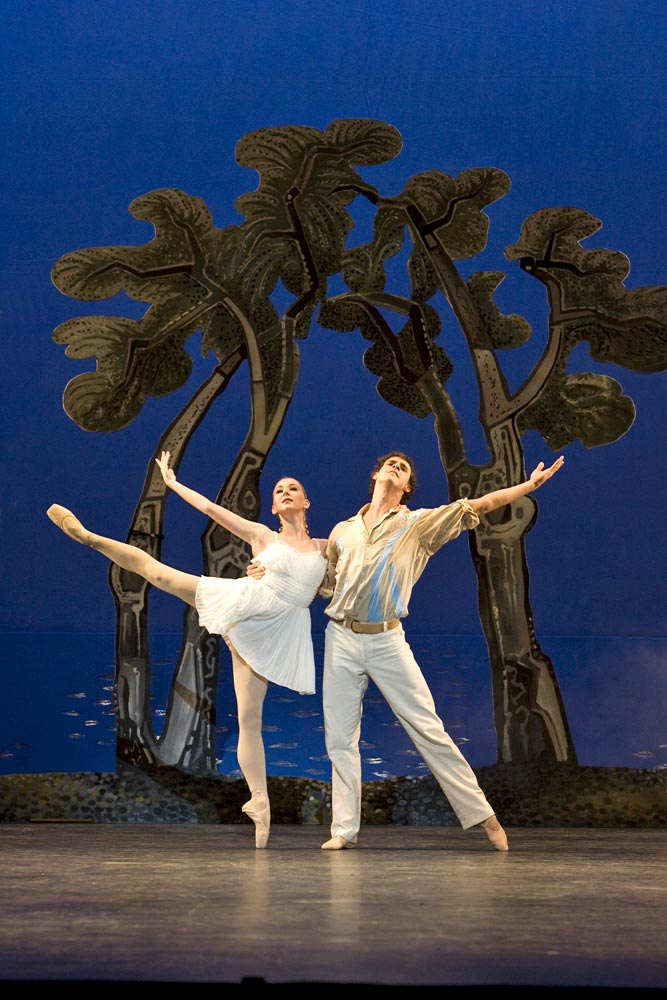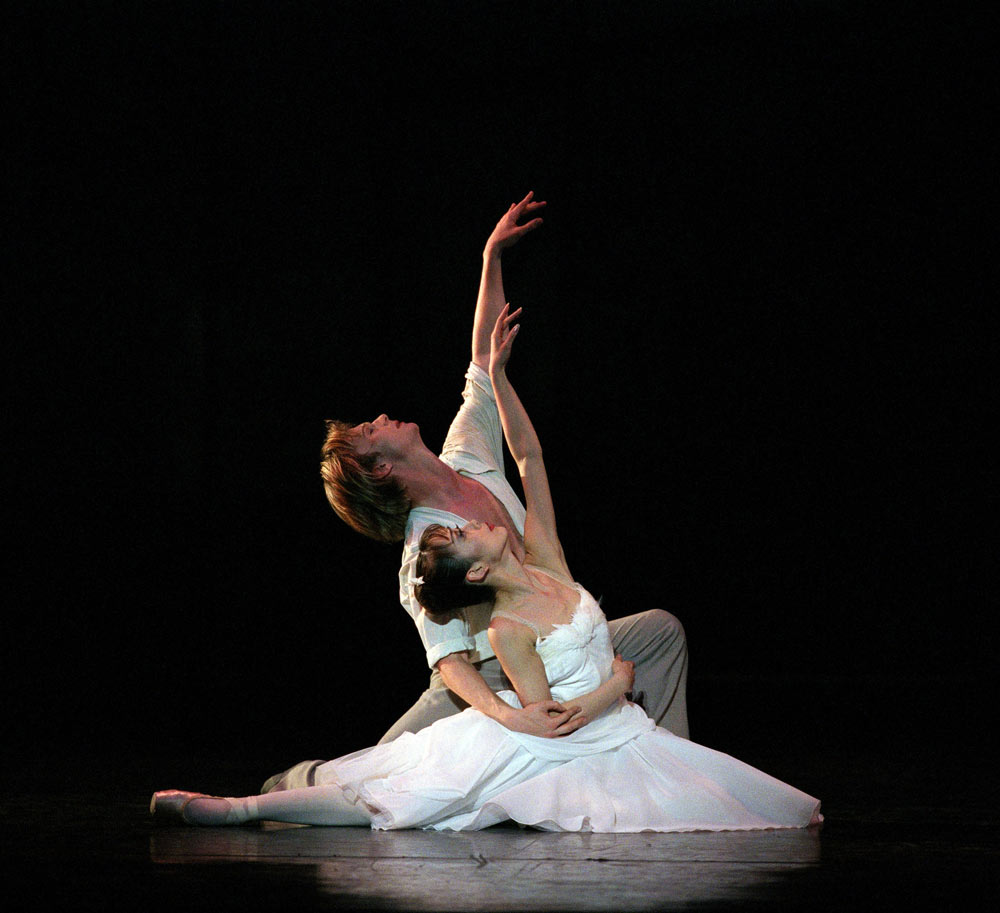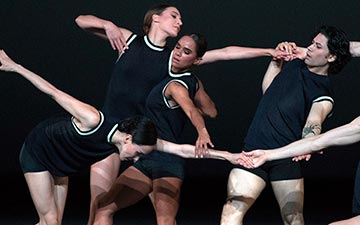
Birmingham Royal Ballet
Daphnis and Chloe, The Two Pigeons
London, Coliseum
13 March 2012
www.brb.org.uk
The Birmingham Royal Ballet’s latest treat for London admirers of Frederick Ashton is a double bill of ballets he created around two of his favourite dancers: Daphnis and Chloe, made for Margot Fonteyn, and The Two Pigeons, inspired by Lynn Seymour. I’m not convinced that the two pieces complement each other particularly well, but each of them has many pleasures and it’s interesting to see how – fifty years on – they survive the loss of their great original casts.
Daphnis and Chloe should be the stonger: Ravel’s great score is a masterpiece in its own right, and John Craxton’s colour-saturated, evocative sets glow with Mediterranean warmth. The second scene, in the pirates’ lair, may be choreographically rather weak, but the simple, grave dances for the corps de ballet in the opening scene, and the joyful finale are top-drawer Ashton. There were some pleasing performances from the secondary characters: Tyrone Singleton’s pirate chief needs only a little more flamboyant relish, Ambra Vallo makes a sultry seductress and Matthew Lawrence a tough, rough Dorkon

Daphnis is a difficult role to bring off. Like Aminta in Sylvia he shows none of the enterprise and courage a modern audience expects from a hero: he lies unconscious on the sea shore until a god brings his abducted lover safely home, and Ashton’s choreography reflects the mildness of his temperament. It takes a strong character to keep our interest and sympathy: Iain Mackay’s amiable niceness isn’t quite enough. Ashton once said that he missed Fonteyn in this ballet more than in any other, and only a couple of the dancers I’ve seen as Chloe in the last twenty years or so have really brought the role to life. Elisha Willis is miscast, I’m afraid: she does the steps brightly and clearly but she doesn’t tell us nearly enough about Chloe’s heart or her soul: our own hearts aren’t touched, and the ballet misfires.
Two Pigeons, of course, was made for this company, and has remained almost its exclusive property over the succeeding fifty years. On the surface it’s a much less sophisticated work than Daphnis and Chloe and when it was new there were critics who rather looked down on it – a charming Valentine card, perhaps, but not to be taken seriously, what with all that pretty music and the live pigeons. It has survived very well, though: if you remember Lynn Seymour you can see her influence, and her feet, everywhere, but she has had some very fine successors and the piece is cleverly made as well as having, in the final pas de deux, one of Ashton’s greatest inventions. Some exaggeration has crept in over the years – I don’t remember the posh visitors to the gypsy camp being so very tittupy, for instance – but the charm is still there.

Nao Sakuma, in Seymour’s role, didn’t quite reach the heights in the last minutes, but she was sweet and funny in the first scene; and in any case the evening really belonged to Robert Parker, giving his last performance in London and challenging memories of almost any of his predecessors. Whilst being very, very charming he also has some of the toughness which I think Ashton originally intended, and the sincerity of his regret at the end was entirely convincing. He will be sadly missed.

















Some impressions from 13 March 2012:
I have always found Ashton’s Daphnis and Chloë a long haul. But as danced by BRB, Ashton’s control of the music is evident. The Two Pigeons too is an hour of dance but protracted by an interval. Might not the sightseers who open the second act be staged in front of the drop cloth, to avoid the break?
Who else but Ashton would allow Daphnis and Chloë to first meet centre stage – and then walk away from each other. When the ensemble form a diagonal line to face the cave, upstage right, who else would deny the expected vision of Pan – with Daphnis and Chloë moving in an echoing diagonal, walking from upstage to downstage left. In the opening scene the Attic formations are the inevitable visualisation of the music.
I am less convinced by the pirates’ lair. BRB attacked the choreography but this protracted scene lacks conviction. So too in Pigeons, the gypsy scene drags. But in Daphnis, the closing scene, created from the simplest straight lines and circles works wonderfully, particularly when danced with BRB’s gusto.
Iain Mackay was a duplicitously obvious Daphnis, best in the first scene. His Chloë, Elisha Willis, made most impression in the exultant reconciliation. Before, her contained acting and restrained physicality did not fully project the choreography.
Matthew Lawrence was a deliciously sleazy Dorkon (looking like a young John Craxton). As Lykanion, Ambra Vallo was a sluttish octopus, entangling Daphnis. Pan’s people, the three nymphs, were properly mysterious.
The dramatic lighting by Peter Teigen brought Craxton’s distinctive designs to vibrant life – but I do prefer Martyn Bainbridge’s redesign.
The fettered Chloë and bound young man in The Two Pigeons offer a more fetishistic view of love than Ashton’s ribbon play in La Fille mal gardée. It’s hard to see Two Pigeons other than a footnote to Fille. There’s a depth to the central couple but what surrounds them is slight.
The ballet lived with Nao Sakuma as the girl – capricious, charming, crisp – far removed from the porcelain brittleness I see from her in classical roles. Robert Parker was the dream boy from next door – masculine, charming, funny. Every movement had meaning.
The reconciliation duet made the performance. Here was a chaste, juvenile precursor of the latently physical duet for Natalia and Beliaev in A Month in the Country (created only 15 years later but from this perspective, worlds away).
A pity the closing moments were marred by a loose bowelled pigeon.